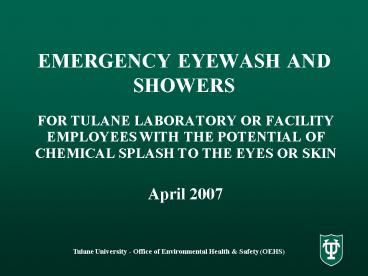EMERGENCY EYEWASH AND SHOWERS - PowerPoint PPT Presentation
1 / 16
Title:
EMERGENCY EYEWASH AND SHOWERS
Description:
If signage or inspection tags are needed for an eyewash or shower in your area, contact OEHS. ... Eyewash/shower equipment needs to be easily located, ... – PowerPoint PPT presentation
Number of Views:3632
Avg rating:3.0/5.0
Title: EMERGENCY EYEWASH AND SHOWERS
1
EMERGENCY EYEWASH AND SHOWERS
- FOR TULANE LABORATORY OR FACILITY EMPLOYEES WITH
THE POTENTIAL OF CHEMICAL SPLASH TO THE EYES OR
SKIN - April 2007
2
OBJECTIVES
- To review the ANSI guidelines for emergency
showers, plumbed eyewashes, personal eyewashes,
and drench hoses - To review concerns noted during OEHS inspections
- To review responsibilities and the need for
testing of emergency showers and eyewash equipment
3
EMERGENCY SHOWERSTHE FOLLOWING ARE ANSI
GUIDELINES
- Showers shall be no more than 10 seconds from the
hazard. - Showers shall be located on the same level as the
hazard, and the path of travel shall be free of
obstructions. - Showers shall be identified with a highly visible
sign.
4
EMERGENCY SHOWERSTHE FOLLOWING ARE ANSI
GUIDELINES
- Valve actuators shall be not more than 69 inches
above the level on which the user stands. (Note
The Americans with Disabilities Act requires that
shower handles extend to 48 inches from the
floor.) - The valve shall remain on without requiring use
of operators hands until intentionally shut off. - Showers shall deliver 20 gal/min of tepid water
for a minimum 15 minute period. - There is no mention of floor drains in the ANSI
Standards. They are not required.
5
EMERGENCY EYEWASHESTHE FOLLOWING ARE ANSI
GUIDELINES
- Eyewashes shall be no more than 10 seconds from
the hazard, and shall be immediately adjacent for
a strong acid or caustic. - Eyewashes shall be located on the same level as
the hazard and the path of travel shall be free
of obstructions. - Eyewashes shall be identified with a highly
visible sign.
6
EMERGENCY EYEWASHESTHE FOLLOWING ARE ANSI
GUIDELINES
- Eyewashes shall deliver 0.4 gal/min of tepid
water for a minimum 15 minutes. They shall
provide flushing fluid to both eyes
simultaneously. - Nozzles shall be protected from airborne
contaminants, and removal shall not require a
separate motion by the activator of the unit.
7
EMERGENCY EYEWASHESTHE FOLLOWING ARE ANSI
GUIDELINES
- The valve shall remain on without requiring use
of operators hands until intentionally shut off. - Plumbed equipment shall be activated weekly to
verify proper operation.
8
PERSONAL EYEWASHEQUIPMENT(such as squeeze
bottles of flushing solution)THE FOLLOWING ARE
ANSI GUIDELINES
- Personal eyewash equipment supports plumbed and
self-contained units, but shall not replace them. - Instructions and expiration date shall be
permanently affixed to the unit. - Flushing fluid temperature shall be tepid.
- A personal eyewash may be kept in the immediate
vicinity of a potential hazard, but after
immediate flushing, the injured person should
then proceed to a plumbed eyewash for the
required 15-minute period.
9
PERSONAL EYEWASHEQUIPMENT(such as squeeze
bottles of flushing solution)
- OEHS does not recommend personal eyewash
equipment because it does not supply a 15-minute
supply of water to properly wash the eyes in an
emergency. - Personal eyewash equipment may be used in field
areas where there is no water source until the
person can get to a proper eyewash station
however, the equipment must be maintained (no
expired date on flushing solution, bottle kept
clean and free of debris, etc.)
10
HAND-HELD DRENCH HOSESTHE FOLLOWING ARE ANSI
GUIDELINES
- Hand-held drench hoses provide support for
emergency shower and eyewash units but shall not
replace them. - Drench hoses shall be identified with a highly
visible sign. - Drench hoses shall deliver a minimum of 3 gal/min
of flushing fluid for a minimum of 15 minutes. - Delivered flushing fluid temperature shall be
tepid. - Plumbed equipment shall be activated weekly to
verify proper operation.
11
TESTING EMERGENCY EYEWASHES AND SHOWERS
- ANSI recommends eyewashes and drench hoses be
activated weekly. At Tulane, this is the
responsibility of the PI or supervisor of the
area. Problems should be reported to Facilities
Services. - Weekly flushing of plumbed eyewash stations is
critical to lower bacterial contamination and to
remove impurities in the plumbing lines. - Showers must be tested at least annually by
Facilities Services.
12
EMERGENCY EYEWASHES AND SHOWERSCONCERNS NOTED
DURING ANNUAL OEHS INSPECTIONS
- Equipment located too far away (10 seconds away)
in hazardous areas (esp. if corrosives or
formaldehyde are used) - Signage or inspection tags are needed
- Equipment not being inspected on a regular basis
- Plastic eyewash bottles are dirty or have expired
solutions
13
EMERGENCY EYEWASHES AND SHOWERSCONCERNS NOTED
DURING ANNUAL OEHS INSPECTIONS
- Obstructions are preventing access to equipment
- Shower pull chain is too high
- Eyewash located in radioactive sink
- Eyewash or shower is needed in work area due to
use of corrosives or irritants - Plumbed eyewash or shower needed, but only drench
hose or personal eyewash bottle available
14
EMERGENCY EYEWASHES AND SHOWERS
- If signage or inspection tags are needed for an
eyewash or shower in your area, contact OEHS. - For additional information on eyewashes or
emergency showers, see OEHS Policies and
Procedures Manual which can be found on the OEHS
website, www.som.tulane.edu/oehs.
15
EMERGENCY EYEWASHES AND SHOWERS - SUMMARY
- Plumbed emergency eyewash and shower equipment is
needed in work areas where corrosive or
irritating chemicals are used. - Eyewash/shower equipment needs to be easily
located, unobstructed, tested and maintained. - ANSI guidelines give details on the requirements
and proper operation of emergency eyewash and
shower equipment.
16
Tulane UniversityOffice of Environmental Health
Safety (OEHS)Pam Fatland pfatlan_at_tulane.edu
Manager, Chemical Safety(504)
988-2800www.som.tulane.edu/oehsIf unable to
proceed to quiz, type the link below into your
browserhttp//aurora.tcs.tulane.edu/ehs/enterssn.
cfm?testnum13
Proceed to Quiz































